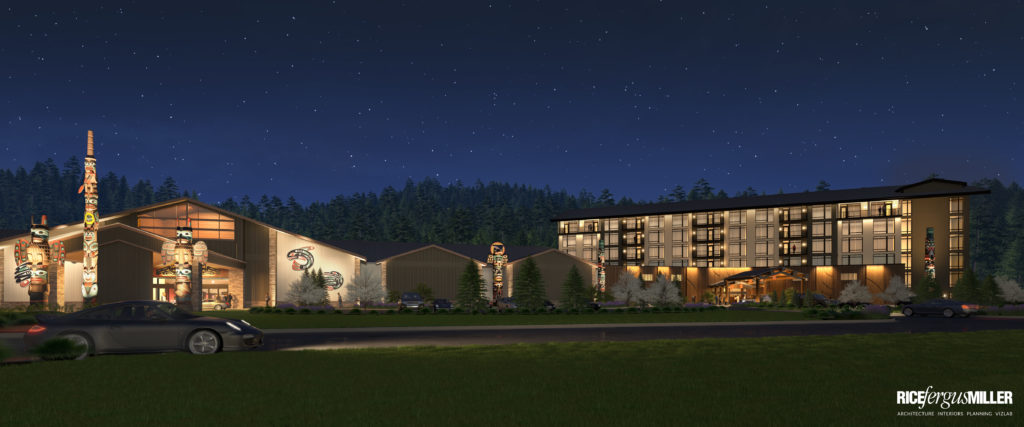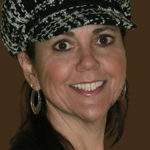How 7 Cedars Casino weaves strategy and story into two major projects
It’s hard to tell just one story about the Jamestown S’Klallam Tribe. Do we start with the diversity of their enterprises, including gaming, seafood and shellfish, health centers and their award-winning golf course, all under the leadership and acumen of Chairman Ron Allen for more than four decades? We can explore the Tribe’s commitment to their broader community and their role as conservators of the land. And it’s tempting to dive into the unique history of a Tribe who pooled $500 in gold coins in 1874 and purchased land, securing their home for generations to come, when Native Americans across the country weren’t allowed to do so.
For this article, we’ll focus on the lessons and insights from two major development projects and investments for 7 Cedars Casino that will have long-term impacts to not only their bottom line, but to the community in which they live, and how they’ve weaved their unique story and culture into every aspect of these projects.
Find us where the rainforests meet the ocean
About two hours west of Seattle, guests cross the Puget Sound to find a rural casino with just over 600 slots and 30 table games facing the Strait of Juan de Fuca; their backyard, the Olympic National Park. Visitors are greeted by seven majestic totem poles, some built with wood over 900 years old. Although there are 29 casinos operated by 21 Tribes in the state of Washington, 7 Cedars Casino is far removed from the larger gaming resorts that service the metropolitan areas.
The area is surrounded by neighboring lavender farms and is the gateway to the rich outdoor playground of the Olympic Peninsula, of sea and forest, attracting golfers, fishermen, whale-watchers, kayakers, mountain bikers and hikers (and Twilight movie fans who pass by).
What casino guests won’t find at 7 Cedars Casino or in the surrounding area is a four-star, four-diamond resort. And here lies the opportunity.
According to Jerry Allen, CEO, 7 Cedars Casino, “Right now people don’t come to the peninsula if they’re looking for top-level amenities. They’ve got other choices from the north, to Whistler, to the south to Bend, Oregon, and to the east. There’s been a big hole in where they can stay here.”
Allen and his team, including long-time General Manager Glenn Smithson and Marketing Director Judy Walz, have been promoting for a hotel for years. Although the casino has been in operation since 1995, other Tribal enterprises took precedence over the long-awaited hotel, which is slated to open Memorial Day, 2020.
Allen shared, “The timing had to do with the Tribe prioritizing how the community was going to be serviced properly. Whether it was the health care center or dental clinic, or other job-creating economic ventures. Without having some of those services that a lot of typical Tribal communities have, there was definitely a time and a place for us to begin.” And when the project was scheduled to launch in 2008, the Tribe determined that a delay was prudent due to the national financial downturn at that time.
During the last decade, the team continued to build their product in many ways, expanding their gaming floor and producing a master plan that reflects the needs not only of the 7 Cedars Casino market, but the community at large. An in-depth hotel feasibility study ultimately led to the two major projects we’re covering in this article: a reimagined food venue and the groundbreaking of their first hotel.
Phase One: Goodbye buffet, hello farm-to-table
Buffets are traditionally loss-leaders and used as a tool for casino player development. But how much does driving people through the door and comping good players cost? According to Smithson, “Originally, we were losing $1,000,000 plus annually, and had been for some time. We had daily $4.95 steak specials, of which we sold around 10,000 per month. We did a seafood buffet on Fridays and Saturdays. The food cost on the steak special was covered, but we lost money on the labor and other normal expenses; we were focusing on traffic generation and draw for potential gaming dollars.”
Through implementing player tracking software, the team found out that F&B guests who they thought were good players were not, so it was time for a new philosophy. Smithson added, “We had a vision of a new food concept and venue that could accommodate a new and soon-to-come hotel.”
With the support of research, they closed the Salish Buffet and opened the House of Seven Brothers Restaurant last summer. It’s designed after a traditional long-house and named after a long-ago story of the Tribe. According to their website it was “… inspired by the Tribe’s ancestral connection to our local waterways and the bounty they provide … it features locally sourced seafood, produce, and protein from fishermen, farmers, and ranchers across the Olympic Peninsula.”
Smithson shares, “Our design features an action/exhibition kitchen. True farm-to-table from seafood to produce. We now offer 90 percent fresh from scratch menu items and dishes.” A striking design feature is seven masks specifically commissioned for the project.
And was the risk of removing a traditional guest-favorite worth it? According to Smithson, “We now have an F&B operation that is profitable, with sales growth of 20 percent and a venue designed to be nimble moving forward. Gaming proceeds are up significantly as well. Another surprise; while the buffet was down for construction, we had to steer our guests to dine at our Napoli’s deli. That business grew over 80 percent during that phase. When the House of Seven Brothers opened, Napoli’s had a new following. That venue has maintained a 30 percent growth since then.”
In addition to financial results, Smithson shared, “There’s team member pride and ownership with this new concept; it’s an open palate for creativity. Tribal members and team members are so proud, and our guests show to be very appreciative of the finished product.”
There’s been one partner who has been integral in the transformation of the casino, since the expansion of their casino space. Rice Fergus Miller Architecture (RFM) has worked side by side to create the vision of the Tribe, and who Allen says, “They’re not trying to make us somebody or something that we’re not. Anytime you can have people treat your money like their money, then you’ve got a lot on your side. From myself and my brother, Ron’s position, there’s a more personal approach to what we do here, with this team of people that we like very well.”
The admiration is mutual. Jennifer Fleming, Designer and Principal of RFM, shares, “The firm started working with Jamestown S’Klallam and the 7 Cedars Casino property in 2005. I joined the firm that year straight out of college and was a junior person on the team. Now it’s almost 14 years later and it’s been amazing to be a part of their project. They are like family to me. There’s something very unique about Jamestown. They are a smaller Tribe. I think that allows the opportunity for a design team to be more deeply entrenched in the project, versus sometimes when you work with larger organizations, you’re kind of just another cog in the wheel, and you have a role. This is the only Tribe that I work with where I can text the chairman of the Tribe!”
With the completion of the restaurant, with a design venue worthy of a four-star 100-room hotel, the ribbon was cut in mid-February with RFM and longtime construction partner, Swinerton, at the ready.
Phase Two: A hotel experience that combines new technology with the Tribe’s cultural themes
When interviewing Allen and Walz about the hotel project, their excitement and conversation enthusiastically bounces back and forth between the experience they are creating for guests in every room through technology and integrating the Tribe’s culture and influences.
You can tell in her voice, just how eager Walz is about the technology, “We’re using the INTELITY system. It starts with keyless entry. The guest rooms are Bluetooth-enabled. You can cast anything that’s on your mobile device onto the TV. Imagine a tablet in your room that lets you request room service, housekeeping, to turn down the lights or to open up the drapes. A lot of our collateral will be digital. It’s just an easier way to connect and is meant to ease your experience while you’re a guest.”
And when it comes to technology, sometimes designers miss the obvious, but not in this case. Fleming adds, “We built out a model room, and Chairman Allen is there and we’re measuring and taping off where he wants every outlet, just to make sure that it’s going to suit that business traveler. You know, because that’s who Ron is. It’s been unique to be able to work with a client who is so hands-on, who cares so much.”
Tribal members and team members alike have tested the mattresses and explored the space. “Jerry has included a lot of us in every one of these design meetings with RFM; food and beverage, gaming, marketing, facilities. Everybody has been involved and knows what’s happening, what’s going on and has input,” Walz commented.
The design choices use natural elements spanning from water to sky – that will visually tell the story of the Pacific Northwest, as well as the Northwest region Tribes’ history and culture down to every fiber. Fleming shares, “We derived a pattern for the custom carpet in the guest-rooms based on cedar hats from Chairman Ron Allen’s personal collection. The carpet in the corridor is designed to look like water meeting the shoreline, and the shoreline side of the carpet reveals a Tribal pattern.”
Each of the five floors will have different elements and feature more custom Coast Salish artwork from Oregon, Washington, up through the coast of British Columbia and, in particular, southeast Alaska. They’ll be making the lobby seasonal to keep the artwork fresh. “We’re not only using our local native and non-native artists who are specialists in native art, but we’re also using contemporary photography that highlights the Olympic Peninsula,” added Allen.
Another unique design element is the facade of the ground floor of the property. Seven panels are being made out of more contemporary wood material. According to Fleming, “These seven art panels are like a modern take on a totem pole because it’s horizontal across the face of the property rather than vertical.”
Expectations and future plans
Rooms in this first phase will be primarily for gaming guests. When asked about more rooms for outer-markets and non-gamers, Allen responded, “We’ll see how the revenue expectations become reality, but these gaming markets are only so deep. You have to diversify. And when you talk about phase two and three, then it’s really about a destination experience, not as much as a casino hotel. After the first year, it will be about really getting our arms around the right heads in the beds. We’ll then have a better understanding of what is true about the gamer and how much it’s really about the destination guest.”
They’re also working on several ideas to enhance the experience from a consumer standpoint. “One great guest experience being done in Coeur D’Alene, is that if you’ve got a golf package and you’re pulling up to our hotel, we’ll take your clubs from you and they’ll be sitting in your cart when you arrive at the golf course. There’s a lot of those personal amenities that we want to do that will meet everyone’s highest expectations,” added Allen. He also mentioned car charging units and bikes to access nearby trails.
Moving forward, both Allen and Walz said they gathered a lot of ideas from other Washington casino resorts and will continue to do so. Walz added, “As you know, we network very nicely up here in Washington with our other sister Tribes. We’ve gone to those other properties and Glenn’s got a lot of analysis from them of what incremental lift that hotel will bring to the gaming side of it.” It’s not surprising that the other Tribes have given support: the Jamestown S’Klallam Tribe is known for their commitment to improving the lives of American Indians and Alaska Natives and their willingness to share their knowledge and experience.


